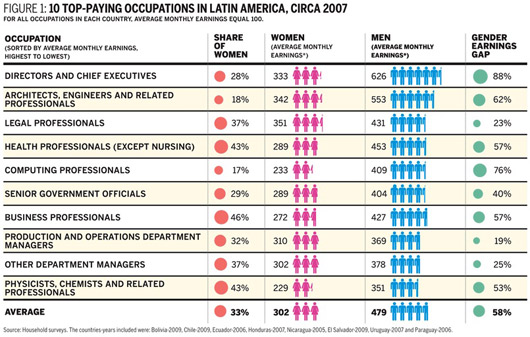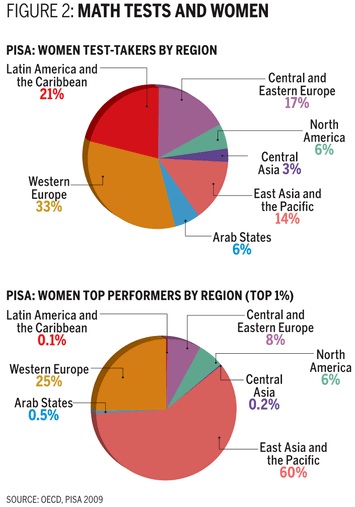Women’s socioeconomic and political progress advanced dramatically across the globe in the last half of the twentieth century, especially in Latin America and the Caribbean. Yet gender disparities remain high, and bridging those gaps has been a slow process. This is partly explained by negative stereotypes and misguided perceptions of gender roles—both still prevalent in Latin America. Such stereotypes not only distort many social interactions at home and in the workplace; they act as disincentives for girls to apply themselves in advanced study—particularly in mathematics.
Just as significantly, they affect the overall labor supply. In both formal and informal labor markets, where Latin American families get 80 percent of their total income, gender gaps remain. Although the level of women’s participation in the workforce has markedly increased over the past two decades across the region, three out of every five workers are male.
Since the beginning of the 1990s, the proportion of working-age women in the labor market has increased from one-half to two-thirds, with married and cohabiting women leading the charge. Many of those women married more educated husbands or were unburdened by dependents such as children or elderly relatives.
The gender inequalities extend to salaries. In my recently published book, New Century, Old Disparities: Ethnic Earnings Gaps in Latin America and the Caribbean, we document that—based on representative data from 18 countries in the region circa 2007—males earn from 29 to 31 percent more than females with the same age, level of education, number of children, presence of other income earner at home, type of employment, and average hours worked per week.
This has improved only marginally from two decades ago, when the same metric was from 33 to 35 percent.
Facing the Glass Ceiling
Female underpayment in the labor market is more pronounced among informal workers, the self-employed, workers in small firms of five employees or fewer, and part-time employees working at most 30 hours per week.
Females dominate the part-time economy. It is a convenient way for them to both enter the workforce and design flexible hours around household responsibilities. One in four female workers is a part-time employee, compared to only one in 10 male workers. Examples of popular flexible-hour professions include domestic workers and pre-school teachers. But the flexibility for females comes at a cost—reflected in the earnings penalties they absorb.
Women work more hours than men overall, but they are not fully compensated for those hours. Recent data from official national household surveys in Colombia reveal that in a typical week, working men and women devote an average of 48 and 40 hours, respectively, to paid work and 13 and 32 hours, respectively, to unpaid work such as household responsibilities.
There are perceptions about gender roles that limit women’s bargaining possibilities in the search for a fairer split of chores within their households. The 2009 Latinobarómetro survey, administered across 18 countries in Latin America, reports that one-third of respondents agree with the statement, “It is better to have women at home and men at work.”
Thus, in the limited scope for such a fairer split of responsibilities, women often resort to more flexible segments of the labor markets. Doing so limits their access to top-paying occupations in the long term, illustrating a glass ceiling that hinders—or even blocks—their movement up the corporate ladder.
Household surveys from eight Latin American countries show that, out of 10 top-paying occupations, including CEO, architect, lawyer, doctor, physicist, and production manager, women hold a smaller share of these lucrative posts compared to men. Indeed, the gender-based earnings gaps among these high-paying occupations are more pronounced than in the rest of the labor market. That is, flexible and top-paying occupations show higher gender earnings gaps than the rest of the labor markets. [See Figure 1] Many of these high-paying positions rely heavily on quantitative skills—an area in which males of the region still have more training, despite the gains that females have made in terms of general schooling.

Women in Education
Gender disparities in the workforce are perplexing—particularly in light of evidence that suggests females across Latin America and the Caribbean are actually outpacing males in educational attainment.
Our research team at the Inter-American Development Bank has found, for example, that females born by 1980 attended, on average, one more quarter of a school year than males (9.5 versus 9.2). In contrast, males born by 1940 achieved, on average, one extra year of schooling over females (6 versus 5).1 This gender educational attainment gap reversed from being male-dominated to female-dominated on a regional level beginning with the cohort born in 1968.
The higher schooling attainment of women is clearly seen among the highest educated. While by 1992, 16 percent of working females and 11 percent of working males in Latin America either partially or fully completed tertiary education, by 2007 those distributions were 26 percent and 17 percent, respectively. Moreover, the global phenomenon of higher schooling achievement among females began earlier in Latin America than in the rest of the developing world.
The only countries in the region where boys still attain more schooling than girls are Bolivia and Guatemala—two countries with sizable Indigenous populations—which suggests important links to ethnicity, culture and gender parity.
Yet despite the fact that females are staying in school longer, their test scores in math still fall short of males’.
Consider data from the Organisation for Economic Co-operation and Development (OECD)-administered Programme for International Student Assessment (PISA). The 2009 PISA was applied to more than 475,000 students in 65 countries, with 97,000 of them from nine Latin American and Caribbean countries: Argentina, Brazil, Chile, Colombia, Mexico, Panama, Peru, Trinidad and Tobago, and Uruguay. Boys outperformed girls in the quantitative section of the test in 35 out of 65 countries—including in seven out of the nine Latin American nations. Only in Trinidad and Tobago did girls outperform boys. In Panama, the gender differences in quantitative performance were statistically insignificant.
Girls still score lower than boys globally in the PISA, but the gap is magnified in Latin America, even more so among the highest performers.
About one-third of the world’s top 1 percent of PISA test-takers are girls: 1,700 students in total. Of this population, however, only two students are from Latin America, despite the fact that about one-fifth of all female PISA test-takers—more than 50,000 students—hail from the region. [See Figure 2]
Compare gender disparity in top performance across world regions. In East Asia and the Pacific, for instance, 42 percent of top performers are girls and 58 percent are boys—compared to 13 percent and 87 percent, respectively, in the Latin American sample. Indeed, Latin America and the Caribbean has the single lowest share of any global region in terms of the top female PISA math scorers.

This lower mathematics performance also induces gender differences in fields of educational specialization. UNESCO data indicate that by 2008, females across six countries in South America—Argentina, Brazil, Chile, Colombia, Ecuador, and Uruguay—constituted almost 60 percent of all graduates from college programs. Yet they represented only 30 percent of those studying engineering, manufacturing or construction. Women, however, made up a majority of graduates in the fields of education (73 percent), health care and sociology (71 percent).
It’s not a question of global gender inequity. Half of the countries that participated in the 2009 PISA had equal levels of gender attainment. But what do those countries have in common insofar as educational outperformance of Latin America? What makes one country more prone to gender parity in students’ mathematics performance?
Underlying Social Elements
Using data developed by the World Economic Forum and the World Values Survey, Paola Sapienza of Northwestern University’s Kellogg School of Management and her co-authors argued in Science in 2008 that countries with greater gender parity in economic and political opportunities tend to show lower or no gender gaps in math performance.2 The findings lend support to the idea that the current status of adult women shapes expectations for girls and influences and the way girls and boys decide how to apply themselves in their studies, in this case in math. Here, negative stereotypes about gender roles play a role in inducing males and females to pursue certain paths of study.
The idea that math- and science-related work is better suited for boys is rooted in many societies, both in the developed and the developing world. Dario Cvencek and his co-authors from the University of Washington’s Institute for Learning & Brain Sciences provide recent evidence from the United States in a study published in 2011 in Child Development. They found that in a sample of Seattle schoolchildren, primary-school students implicitly and explicitly tended to associate math more with boys than with girls as early as the second grade.
In Cvencek’s research, his team provided students with names of boys and girls as well as with mathematics- and reading-related words (e.g., addition, numbers, graph, books, story, and letter) on a computer screen. In a first set of exercises, students explicitly tended to associate boys’ names with mathematics terms and girls’ names with reading words. In a second set of exercises, researchers provided not only the names and words but also the associations (e.g., Jacob-graph; Joshua-letter; Emily-addition; and Jessica-book). Here, students took longer to react to a female-mathematics association than to any other, revealing a stronger implicit association between gender and field.3
Such perceptions are nurtured by cultural and commercial stereotypes that can have an impact from an early age. Take the “Teen Talk Barbie” doll from the 1990s, which spoke phrases such as, “Math class is tough.” At local toy stores, science- and math-oriented toys are hardly conducive to gender neutrality with respect to their shapes and colors. However, popular culture has begun to address these vestiges of sexism. One example is the famous 2006 episode of The Simpsons titled “Girls Just Want to Have Sums.” These are good signs, but there is still work to do.
Juan Camilo Cárdenas at Universidad de Los Andes in Bogotá and his colleagues from Stockholm provide the most recent evidence of changing attitudes.4 They tested gender differences in competitive settings in 2011, comparing children from Colombia and Sweden—two countries that substantially differ in terms of gender parity. They measured performance for kids aged nine through 12 on four tasks linked to different degrees of gender stereotyping: mathematics, running, word search, and skipping rope. Their study design allowed them to measure competitiveness and risk-taking for performing the tasks. It provided encouraging signs: boys and girls performed equally in mathematics, word search and running in both countries. The dramatic gender gap: boys’ tendency to take risks was significantly higher than that of girls in both countries, but the disparity was even more pronounced in Colombia than in Sweden.
The embedded stereotypes sometimes appear in a seemingly inadvertent or unconscious way. A 2005 study I conducted with Martin Benavides at the Peruvian think-tank Grupo de Análisis para el Desarrollo (Group for the Analysis of Development—GRADE) analyzed the images contained in Peru’s official school textbooks for the fourth, fifth and sixth grades. In the textbook pictures, males outnumbered females two to one. Moreover, males were more likely to be depicted in school and work environments, while the images of females showed them performing household and leisure activities.
Similarly, with colleagues at the Universidad de Los Andes, I analyzed photos of people published in nationally circulated Colombian newspapers and magazines during the second quarter of 2011. At first glance, the gender split seemed unbiased: one-third of the images contained only men, another third only women, and another third both.
However, the context in which they appeared was wildly imbalanced. Women were usually depicted in situations related to health, friendship, love, and beauty; men were pictured in environments denoting entrepreneurship, security and justice. The business publication used in the sample depicted less than one-fifth of women-only images, with only half of those in an environment denoting entrepreneurship, security or justice.
Peeling back the onion of gender disparities in Latin American and Caribbean labor markets reveals gender stereotypes as discomfiting sources of bias, rooted as early as primary school—or before that, at home or in the public sphere.
The effects are tremendous: fewer women pursue an educational path suited to quantitative acumen—skills that pay well professionally—and thus hold fewer positions of leadership. In this regard, regional economies inadvertently limit their development opportunities as they fail to take advantage of the full potential of half of their populations.
Crafting economic policy with gender parity foresight is smart economics.
What can be done? For one, investment in early childhood development is strongly recommended. That is, teaching children before they enter school that “mathematics is for me” and “yes, I can.” Training teachers to eradicate stereotypes works—but only to a fault. It is equally important, if not more, that children learn about gender parity from their parents and support structures at home.
Addressing gender inequality is essential to tackling longstanding—if inadvertent—stereotypes. Expectations of female achievement must be reshaped, because the continuation of an unacceptable status quo will prevent women from realizing their true potential in the workforce.




